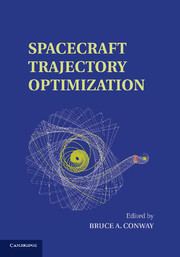Book contents
- Frontmatter
- Contents
- Preface
- 1 The Problem of Spacecraft Trajectory Optimization
- 2 Primer Vector Theory and Applications
- 3 Spacecraft Trajectory Optimization Using Direct Transcription and Nonlinear Programming
- 4 Elements of a Software System for Spacecraft Trajectory Optimization
- 5 Low-Thrust Trajectory Optimization Using Orbital Averaging and Control Parameterization
- 6 Analytic Representations of Optimal Low-Thrust Transfer in Circular Orbit
- 7 Global Optimization and Space Pruning for Spacecraft Trajectory Design
- 8 Incremental Techniques for Global Space Trajectory Design
- 9 Optimal Low-Thrust Trajectories Using Stable Manifolds
- 10 Swarming Theory Applied to Space Trajectory Optimization
- Index
- References
3 - Spacecraft Trajectory Optimization Using Direct Transcription and Nonlinear Programming
Published online by Cambridge University Press: 06 December 2010
- Frontmatter
- Contents
- Preface
- 1 The Problem of Spacecraft Trajectory Optimization
- 2 Primer Vector Theory and Applications
- 3 Spacecraft Trajectory Optimization Using Direct Transcription and Nonlinear Programming
- 4 Elements of a Software System for Spacecraft Trajectory Optimization
- 5 Low-Thrust Trajectory Optimization Using Orbital Averaging and Control Parameterization
- 6 Analytic Representations of Optimal Low-Thrust Transfer in Circular Orbit
- 7 Global Optimization and Space Pruning for Spacecraft Trajectory Design
- 8 Incremental Techniques for Global Space Trajectory Design
- 9 Optimal Low-Thrust Trajectories Using Stable Manifolds
- 10 Swarming Theory Applied to Space Trajectory Optimization
- Index
- References
Summary
Introduction
A spacecraft in flight is a dynamical system. As dynamical systems go, it is comparatively straightforward; the equations of motion are continuous and deterministic, for the unforced case they are essentially integrable, and perturbations, such as the attractions of bodies other than the central body, are usually small. The difficulties arise when the complete problem, corresponding to a real space mission, is considered. For example, a complete interplanetary flight, beginning in Earth orbit and ending with insertion into Mars orbit, has complicated, time-dependent boundary conditions, straightforward equations of motion but requires coordinate transformations when the spacecraft transitions from planet-centered to heliocentric flight (and vice versa), and likely discrete changes in system states as the rocket motor is fired and the spacecraft suddenly changes velocity and mass. If low-thrust electric propulsion is used, the system is further complicated as there no longer exist integrable arcs and the decision variables, which previously were discrete quantities such as the times, magnitudes and directions of rocket-provided impulses, now also include continuous time histories, that is, of the low-thrust throttling and of the thrust pointing direction. In addition, it may be optimizing to use the low-thrust motor for finite spans of time and “coast” otherwise, with the optimal number of these thrust arcs and coast arcs a priori unknown.
Since the cost of placing a spacecraft in orbit, which is usually the first step in any trajectory, is so enormous, it is particularly important to optimize space trajectories so that a given mission can be accomplished with the lightest possible spacecraft and within the capabilities of existing (or affordable) launch vehicles.
Information
- Type
- Chapter
- Information
- Spacecraft Trajectory Optimization , pp. 37 - 78Publisher: Cambridge University PressPrint publication year: 2010
References
Accessibility standard: Unknown
Why this information is here
This section outlines the accessibility features of this content - including support for screen readers, full keyboard navigation and high-contrast display options. This may not be relevant for you.Accessibility Information
- 16
- Cited by
